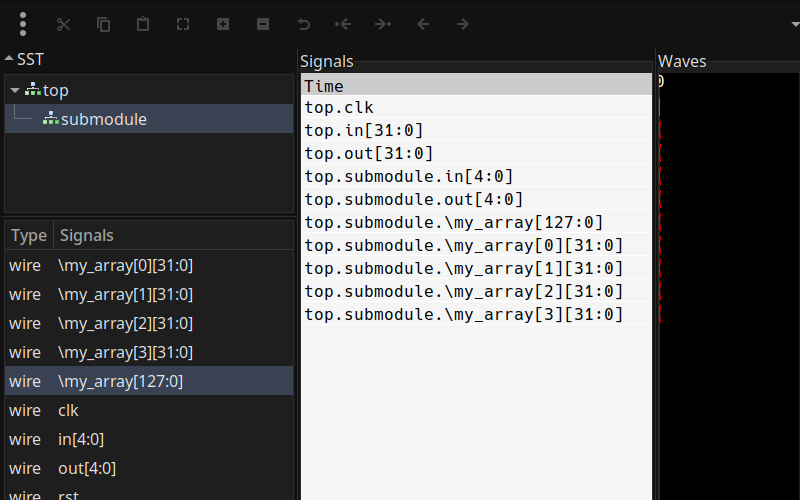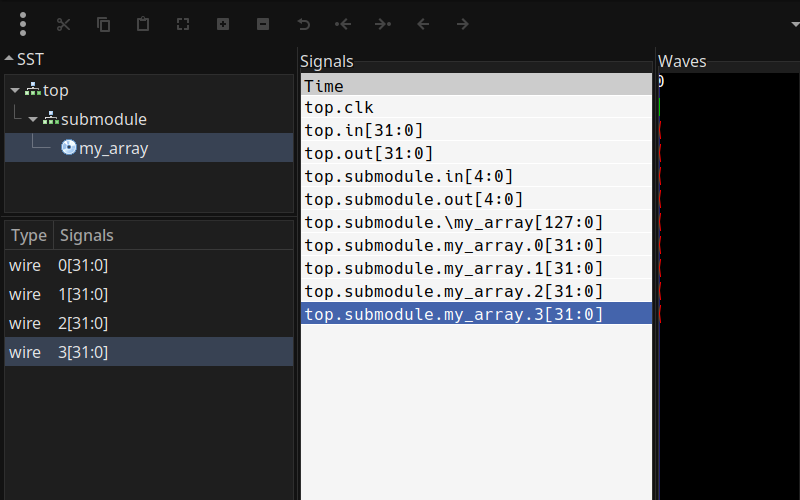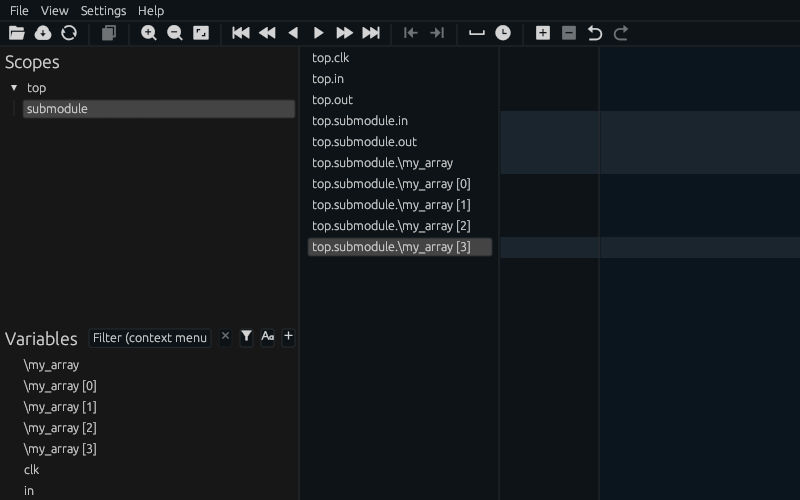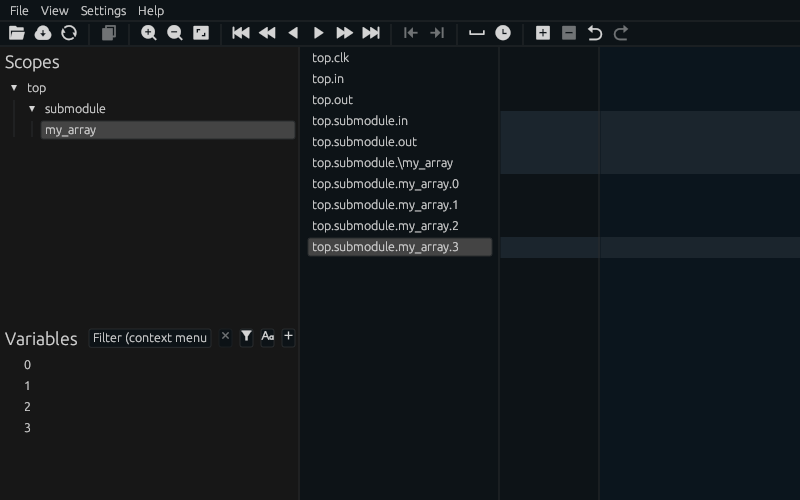- Start Date: 2025-05-12
- RFC PR: amaranth-lang/rfcs#0074
- Amaranth Issue: amaranth-lang/amaranth#1599
Structured VCD Output
Summary
When generating VCD files, use the scope keyword to distinguish aggregate signals.
Motivation
These changes are intended to make it easier for waveform viewers to recover information about aggregate signals from VCD files. This is partially motivated by an issue with VCD parsing that occurs in Surfer (see ekiwi/wellen#36). Ideally, this leads to a better user experience when inspecting simulated Amaranth designs with a waveform viewer.
Guide-level explanation
This RFC describes changes to the way Amaranth generates a VCD file.
When reading a VCD file, waveform viewers like Surfer and GTKWave support use of the scope keyword for organizing variables into groups.
Currently, when writing a VCD file, Amaranth uses the module scope to distinguish between signals belonging to different modules.
For instance:
$scope module top $end # top
$var wire 1 <id> clk $end # top.clk
$var wire 1 <id> rst $end # top.rst
$var wire 32 <id> in $end # top.in
$var wire 32 <id> out $end # top.out
$scope module submodule $end # top.submodule
$var wire 1 <id> clk $end # top.submodule.clk
$var wire 1 <id> rst $end # top.submodule.rst
$var wire 5 <id> in $end # top.submodule.in
$var wire 5 <id> out $end # top.submodule.out
$upscope $end
$upscope $end
However, it does not attempt to use scopes for organizing the members of aggregate signals with array-like or struct-like datatypes.
Instead, when creating VCD variables for aggregate signals, members are distinguished only by appending to the name of the parent signal.
For instance, a signal top.submodule.my_array with the type ArrayLayout(unsigned(32), 4) is currently represented as:
$scope module top $end # top
...
$scope module submodule $end # top.submodule
...
$var wire 128 <id> my_array $end # top.submodule.my_array
$var wire 32 <id> my_array[0] $end # top.submodule.my_array[0]
$var wire 32 <id> my_array[1] $end # top.submodule.my_array[1]
$var wire 32 <id> my_array[2] $end # top.submodule.my_array[2]
$var wire 32 <id> my_array[3] $end # top.submodule.my_array[3]
$upscope $end
$upscope $end
This is not sufficient for explicitly conveying the relationship between aggregate signals and their members to a waveform viewer.
In this case, my_array does not explicitly contain its members, and waveform viewers may only infer this relationship by attempting to recover it from the names.
This RFC proposes the use of scope vhdl_array and scope vhdl_record to pass information about these relationships to a waveform viewer.
After this change, the VCD output above would become:
$scope module top $end # top
...
$scope module submodule $end # top.submodule
...
$comment Flattened representation of 'my_array' $end
$var wire 128 <id> my_array $end # top.submodule.my_array
$comment Hierarchical representation of 'my_array' members $end
$scope vhdl_array my_array $end # top.submodule.my_array
$var wire 32 <id> 0 $end # top.submodule.my_array.0
$var wire 32 <id> 1 $end # top.submodule.my_array.1
$var wire 32 <id> 2 $end # top.submodule.my_array.2
$var wire 32 <id> 3 $end # top.submodule.my_array.3
$upscope $end
$upscope $end
$upscope $end
These images demonstrate the difference in GTKWave output:


... and the difference in Surfer output:


Reference-level explanation
Currently, Amaranth represents aggregate signals in the VCD by appending the names of elements/members to the name of the signal. When simulator output is written to a VCD file, we intend that signals with aggregate datatypes are explicitly given their own scope and split into multiple VCD variables.
Changes to VCD Writing
We propose the following conventions:
- The
modulescope defines a group of signals belonging to the sameModule - The
vhdl_arrayscope defines a group of signals belonging to an array (such as a signal withArrayLayout) - The
vhdl_recordscope defines a structured group of signals (such as a signal withStructLayout,UnionLayout, orFlexibleLayout)
After these changes, this functionality will be enabled by default in the VCD writer. These changes will not be backported to Amaranth 0.5.x. Some users may require compatibility with output that is closer to the actual VCD specification. In this case, users that need the pre-RFC behavior are expected to either:
- Opt-out on a case-by-case basis by passing arguments to
write_vcd()(ie.pure=True) - Opt-out globally by setting an environment variable (ie.
AMARANTH_PURE_VCD=1)
Changes to pyvcd
The VCD writer in Amaranth depends on pyvcd, which represents VCD scopes with a ScopeType enum.
vhdl_record and vhdl_array variants are required to implement this RFC.
Changes to Amaranth Playground
The Amaranth Playground has a waveform viewer that depends on the d3-wave library.
d3-wave has an exported/extensible RowRendererBits class that can be used to implement renderers for particular datatypes.
Custom renderers for aggregate datatypes are required for rendering grouped signals in the Amaranth Playground.
Expected VCD Output: Array-like
from amaranth import *
from amaranth.lib.data import *
foo = Signal(ArrayLayout(unsigned(32), 4))
For ArrayLayout, each element in the array should become a VCD variable whose name is integer array index.
In this case, the signal foo is split into foo.0, foo.1, foo.2, and foo.3:
$scope vhdl_array foo $end
$var wire 32 <id> 0 $end
$var wire 32 <id> 1 $end
$var wire 32 <id> 2 $end
$var wire 32 <id> 3 $end
$upscope $end
Expected VCD Output: Struct-like
from amaranth import *
from amaranth.lib.data import *
foo = Signal(StructLayout({
"a": unsigned(1),
"b": unsigned(4),
"c": unsigned(32),
}))
For StructLayout, each member should become a VCD variable with the member name.
In this case, the signal bar is split into bar.a, bar.b, and bar.c:
$scope vhdl_record bar $end
$var wire 1 id a $end
$var wire 4 id b $end
$var wire 32 id c $end
$upscope $end
Expected VCD Output: Nested Aggregates
from amaranth import *
from amaranth.lib.data import *
class MyStruct(Struct):
a: unsigned(1)
b: unsigned(4)
c: ArrayLayout(unsigned(32), 4),
# A struct-like signal
foo = Signal(MyStruct)
For signals with nested aggregate types, the scopes are nested in the same way that scope module is already used for nested modules.
In this case, the signal foo is split like this:
$scope vhdl_record bar $end
$var wire 1 id a $end
$var wire 4 id b $end
$scope vhdl_array c $end
$var wire 32 id 0 $end
$var wire 32 id 1 $end
$var wire 32 id 2 $end
$var wire 32 id 3 $end
$upscope $end
$upscope $end
Drawbacks
-
VCD is not a particularly efficient format, and this adds even more bytes to generated VCD files.
-
This breaks any existing compatibility with waveform viewers that do not handle the
vhdl_recordandvhdl_arrayscope types. Since these are not part of the VCD specification, some waveform viewers may fail to handle this.
Rationale and alternatives
- The choice of
scope vhdl_arrayandscope vhdl_recordare suggested due to known compatibility with Surfer and GTKWave. However, note that these are not part of the VCD specification (which is somewhat old and under-defined).
Alternatives
- Expose an environment variable (or a parameter in
write_vcd()) allowing users to opt-in/opt-out of structured VCD output - Include support for a different waveform format that has better-defined support for variables with composite datatypes.
Prior art
- As far as I can tell, use of the
vhdl_recordandvhdl_arrayscope types comes from the ghdl/ghdl simulator. - verilator/verilator makes no attempt to use these scope types
- steveicarus/iverilog makes no attempt to use these scopes types
Unresolved questions
None.
Future possibilities
Since this adds more overhead to VCD output, it's worth mentioning that VCD may be unsuitable for testing very large designs. This RFC can also serve as a stepping stone for supporting alternative waveform formats in the future.